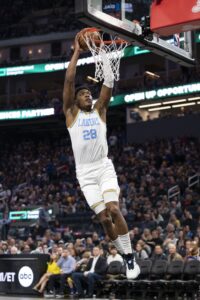Anthony Davis played with Christian Wood in New Orleans, while Lakers head coach Darvin Ham briefly worked with Wood as an assistant in Milwaukee, notes Dan Woike of The Los Angeles Times. Davis’ and Ham’s familiarity with the free agent big man is one reason why the Lakers targeted him as soon as it became clear he might be attainable for the veteran’s minimum.
[RELATED: Christian Wood Agrees To Two-Year Contract With Lakers]
Although Wood remained on the free agent market for more than two months, he’ll likely enter Los Angeles’ training camp as a candidate to start, according to Jovan Buha of The Athletic, who suggests Wood will battle Rui Hachimura and Jarred Vanderbilt for a role in the starting five.
Even if he ends up as a reserve, Wood projects to be Davis’ primary backup in the middle and should play approximately 20 minutes per night, Buha writes. He’ll also provide important insurance if Davis has to miss time due to an injury. Given that AD hasn’t played more than 62 games in a season since 2017/18, that’s a pretty viable scenario.
Here’s more on the Lakers:
- Team sources tell Buha that the Lakers’ roster will likely be set once Wood’s deal is official. That doesn’t mean that the team won’t bring a few more players to training camp on Exhibit 10 contracts, but it means L.A.’s 14 players on guaranteed contracts and three on two-way deals should be the ones who make up the opening-night regular season roster.
- Shortly after word of Wood’s agreement with the Lakers broke on Tuesday night, he tweeted, “It’s always been my dream to be a Laker.”
- Recapping the Lakers’ offseason and previewing their upcoming season, Shaun Powell of NBA.com praises the job that head of basketball operations Rob Pelinka has done in 2023 to add complementary talent around LeBron James and Davis, suggesting that whether or not the club contends for a title this season will ultimately be up to those two superstars.
- In a video clip posted on the Lakers’ official Twitter account, newcomer Cam Reddish said that he’s “really looking forward to” playing with James and Davis. “Two Hall of Fame players,” Reddish said. “I’m just trying to be a sponge, learn everything that I can.”
 According to Brad Turner of The Los Angeles Times (
According to Brad Turner of The Los Angeles Times ( Reaves qualifying offer will be worth a projected $2,219,706 ($200K above his minimum salary); Hachimura’s QO carries a $7,744,600 price tag.
Reaves qualifying offer will be worth a projected $2,219,706 ($200K above his minimum salary); Hachimura’s QO carries a $7,744,600 price tag.